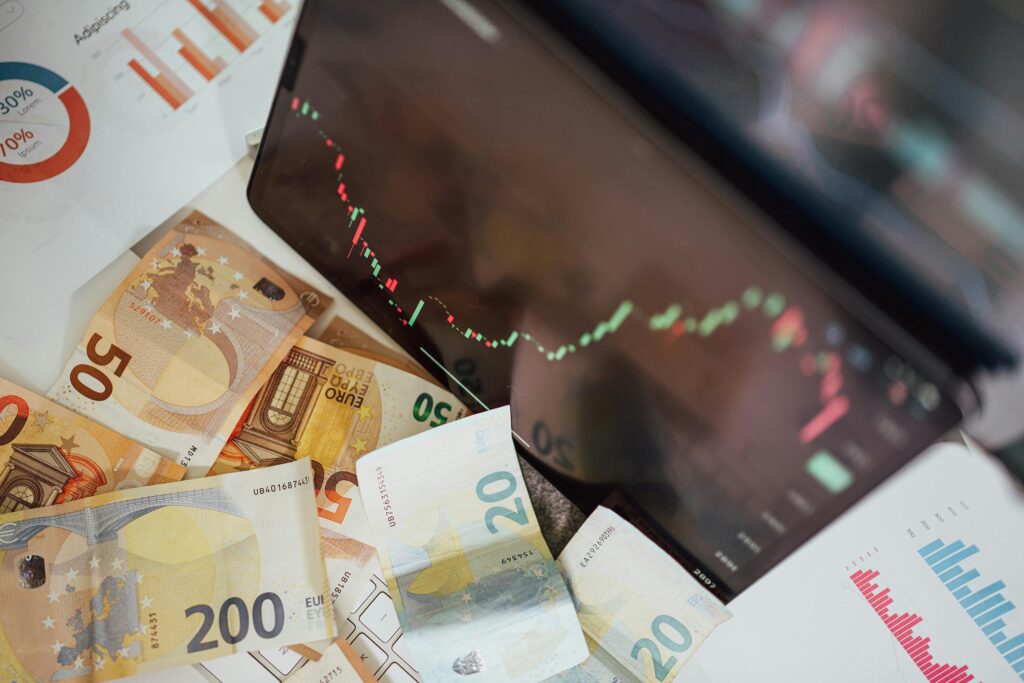What Are ETFs?

Exchange-Traded Funds (ETFs) are investment funds that are traded on stock exchanges, much like individual stocks. An ETF holds a collection of assets, such as stocks, bonds, commodities, or a mix of these, and typically tracks an index or specific sector. By purchasing shares in an ETF, investors gain exposure to a diversified portfolio of assets without needing to buy each asset individually.
Types of ETFs
1. Stock ETFs: These ETFs invest in a collection of stocks and are often designed to track a specific index, such as the S&P 500. They allow investors to gain exposure to the overall stock market or specific sectors (e.g., technology, healthcare) without picking individual stocks.
2. Bond ETFs: These ETFs invest in bonds, providing investors with a way to gain exposure to the bond market. They can focus on government bonds, corporate bonds, or a mix of both.
3. Commodity ETFs: These ETFs invest in physical commodities such as gold, silver, oil, or agricultural products. Commodity ETFs allow investors to gain exposure to the price movements of commodities without having to buy the physical commodities themselves.


Types of ETFs
1. Stock ETFs: These ETFs invest in a collection of stocks and are often designed to track a specific index, such as the S&P 500. They allow investors to gain exposure to the overall stock market or specific sectors (e.g., technology, healthcare) without picking individual stocks.
2. Bond ETFs: These ETFs invest in bonds, providing investors with a way to gain exposure to the bond market. They can focus on government bonds, corporate bonds, or a mix of both.
3. Commodity ETFs: These ETFs invest in physical commodities such as gold, silver, oil, or agricultural products. Commodity ETFs allow investors to gain exposure to the price movements of commodities without having to buy the physical commodities themselves.
4. Sector and Industry ETFs: These ETFs focus on specific sectors or industries, such as technology, healthcare, or energy. They allow investors to target their investments in specific areas of the economy.
5. International ETFs: These ETFs provide exposure to foreign markets, allowing investors to diversify internationally. They may focus on specific countries, regions, or emerging markets.
6. Dividend ETFs: These ETFs focus on stocks that pay dividends, offering investors a way to receive regular income. Dividend ETFs are popular among investors looking for a steady income stream.
7. Thematic ETFs: These ETFs focus on specific investment themes or trends, such as clean energy, artificial intelligence, or blockchain technology. They are designed to capture the growth potential of emerging industries.
8. Inverse and Leveraged ETFs: These are specialized ETFs designed for advanced investors. Inverse ETFs aim to deliver the opposite return of a particular index, while leveraged ETFs use financial derivatives and debt to amplify the returns of an underlying index, either positively or negatively.

How ETFs Work
ETFs are traded on stock exchanges, which means their prices fluctuate throughout the trading day just like stocks. However, unlike mutual funds, which are priced only at the end of the trading day, ETFs can be bought and sold at any time during market hours.
• Creation and Redemption: ETFs are created and redeemed through a process involving institutional investors known as authorized participants. These participants buy the underlying assets and deliver them to the ETF provider in exchange for shares of the ETF (creation). Conversely, they can redeem ETF shares for the underlying assets (redemption).
• Market Price and Net Asset Value (NAV): The market price of an ETF may differ slightly from its NAV, which represents the per-share value of the underlying assets. However, arbitrage opportunities typically keep the market price of an ETF close to its NAV.
Benefits of Investing in ETFs
1. Diversification: ETFs offer exposure to a broad range of assets, sectors, or markets, allowing investors to diversify their portfolios with a single investment.
2. Lower Costs: ETFs generally have lower expense ratios compared to mutual funds because they are often passively managed, tracking an index rather than being actively managed by a fund manager.


Benefits of Investing in ETFs
1. Diversification: ETFs offer exposure to a broad range of assets, sectors, or markets, allowing investors to diversify their portfolios with a single investment.
2. Lower Costs: ETFs generally have lower expense ratios compared to mutual funds because they are often passively managed, tracking an index rather than being actively managed by a fund manager.
3. Liquidity: ETFs can be bought and sold throughout the trading day at market prices, providing investors with greater flexibility and liquidity compared to mutual funds.
4. Transparency: ETFs typically disclose their holdings daily, allowing investors to see exactly what assets they own. This transparency is greater than that of mutual funds, which usually disclose holdings on a quarterly basis.
5. Tax Efficiency: ETFs tend to be more tax-efficient than mutual funds because of the
creation and redemption process, which limits capital gains distributions.
6. Flexibility: With a wide range of ETFs available, investors can tailor their portfolios to meet specific investment goals, whether it’s gaining exposure to certain sectors, asset classes, or market strategies.

Risks of Investing in ETFs
1. Market Risk: Like all investments, ETFs are subject to market risk. The value of an ETF can fluctuate based on the performance of the underlying assets or the broader market.
2. Tracking Error: An ETF may not perfectly track its underlying index or benchmark, leading to differences in performance. This is known as tracking error. While most ETFs are highly liquid, some specialized or thinly traded ETFs may have lower liquidity, making them more difficult to buy or sell at favorable prices.
4. Counterparty Risk: Inverse and leveraged ETFs, which use derivatives to achieve their investment objectives, may carry additional counterparty risk, as they rely on the performance of the derivatives and the solvency of the institutions issuing them.
5. Concentration Risk: Some ETFs may be heavily concentrated in a particular sector, industry, or geographic region, which can increase risk if that area experiences adverse conditions.
How to Invest in ETFs
1. Determine Your Investment Goals: Identify what you want to achieve with your investment in ETFs—whether it’s long-term growth, income, or exposure to a specific market or sector.
2. Choose the Right ETFs: Research ETFs that align with your investment goals. Consider factors like the ETF’s asset allocation, expense ratio, tracking error, and historical performance.
3. Open a Brokerage Account: To invest in ETFs, you’ll need a brokerage account. Choose a brokerage that offers a wide range of ETFs and low trading costs.


How to Start Investing in Stocks
1. Determine Your Investment Goals: Identify what you want to achieve with your investment in ETFs—whether it’s long-term growth, income, or exposure to a specific market or sector.
2. Choose the Right ETFs: Research ETFs that align with your investment goals. Consider factors like the ETF’s asset allocation, expense ratio, tracking error, and historical performance.
3. Open a Brokerage Account: To invest in ETFs, you’ll need a brokerage account. Choose a brokerage that offers a wide range of ETFs and low trading costs.
4. Place Your Order: Once you’ve selected your ETFs, you can place an order to buy shares. You can choose between a market order (buying at the current market price) or a limit order (buying at a specific price).
5. Monitor Your Investments: Keep an eye on your ETFs and the underlying assets. Adjust your portfolio as needed based on changes in the market or your financial goals.

Conclusion
ETFs are versatile and cost-effective investment vehicles that provide a simple way to gain diversified exposure to various asset classes, sectors, and strategies. Whether you’re a beginner investor or an experienced trader, ETFs can play a valuable role in your investment portfolio. By understanding how ETFs work and carefully selecting the right ones, you can take advantage of the many benefits they offer while managing the associated risks.
Frequently Asked Questions
How does this overall process work?
Our alerts are designed to be simple and straightforward. Here’s how you can start making profitable trades:
Open a Brokerage Account:
– Sign up with a reputable online brokerage (e.g., E-TRADE, Robinhood).
Understand the Signal:
– Read the signal details: stock code, buying price, holding period, and expected profit.
Place the Trade:
– Log into your brokerage account, search for the stock, and place a buy order at the recommended price.
Exit the Trade:
– Sell the stock at the recommended exit point or within the holding period.
Review and Learn:
– Check your results and note what worked for future trades.
Example:
Signal Received:
Stock Code: GRİ
Buying Price: $2.10 – $2.35
Holding Period: 3-7 days
Expected Profit: 10-25%
Steps:
Open: Log into your brokerage account.
Search: Look for stock code “GRİ.”
Buy: Place a limit order to buy at $2.10 – $2.35.
Sell: Place a limit order to sell at the recommended exit price.
Review: Check your profits and learn from the trade.
Is it the right time to invest in stocks?
What happens after I purchase the membership?
Can the number of alerts vary?
Contact Us
Please get in touch if you need any assistance, services, or questions!
- info@ustradeclub.com
